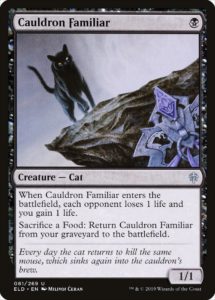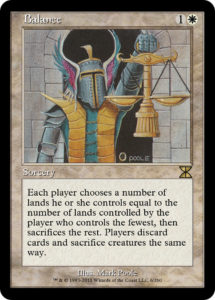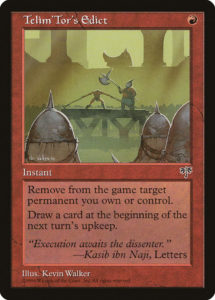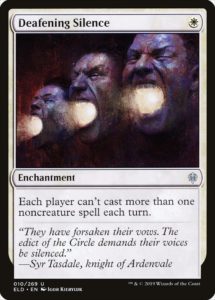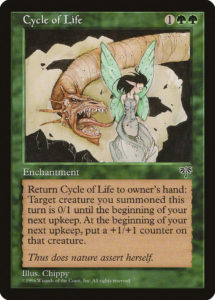Two months ago, we discussed how four annual bans have become the standard for Standard. The format’s first twenty years were defined by infrequent bans. When bans were necessary, they came with explanations. Wizards explicitly recognized how bans damage confidence, both in cards being safe to acquire and Wizards’ ability to create balanced, enjoyable formats.
A New Record
Yesterday, Cauldron Familiar, Growth Spiral, Teferi, Time Raveler, and Wilderness Reclamation were banned. They join Field of the Dead, Oko, Thief of Crowns, Once Upon a Time, Veil of Summer, Agent of Treachery, and Fires of Invention on the bench.
These changes set not only a new recent record for most bans in a single year (2005 and 1999 had eight, but 2020 still has Zendikar Rising), these ten cards set the record for most cards banned from a Standard environment ever. Urza’s block? Eight cards. Affinity in Mirrodin? Nine. BfZ-Amonkhet? Nine. Yesterday’s announcement doesn’t mark this grim milestone, nor does it mention how Wizards feels about bans. For the three cards being banned a month before they would rotate, Play Design viewed “this set of changes as an early rotation for those cards to help freshen up the remaining summer metagame.”
I have some concerns.
Mitigating Factors
Before getting into the concerns, let’s be absolutely clear: I am not attacking Play Design, nor is it appropriate for anyone to harass them. There are several things beyond their control that make bannings more likely.
1. Standard is stronger.
Play Design was tasked with intentionally increasing the power level of Standard. This went into strong effect a year ago, making 2019-2020’s cards more likely to outshine previous cards. Unintentionally overpowered cards were especially overpowered, since they were designed for a higher baseline power level than 2018-2019’s unintentionally overpowered cards.
2. Standard has more scrutiny.
The pandemic has put paper Magic mostly on hold. With most non-rotating formats only playable via Magic Online or webcam, Constructed players are funneled into Standard and Historic. Standard had been on the decline in recent years and suddenly far, far more people were playing it. Larger audiences put more strain on the format, since it was getting solved faster while also having to accommodate large playerbases of differing skill levels (the banning article made of point of distinguishing between the unhealthy competitive metagame and diverse casual metagame).
3. Magic is more digital.
With so much play migrating to Magic Arena, the financial sting of bans is mitigated. If Standard decks aren’t several hundred dollars and it’s feasible to grind a top tier deck without spending money, there’s a weaker argument that consumers are financially damaged by bans.
4. Game design is hard.
Magic design has an incredible challenge: releasing a Standard set every quarter. Each set will be played by millions of people. Each card will be meticulously scrutinized the moment it’s revealed. A small handful of game designers are tasked with designing exciting, set-selling cards that play nicely with every other set in the preceding, same, and following year. They have hundreds, maybe a few thousand person hours to accomplish this. That effort will be dwarfed by their community’s before the set is out for an effort.
So yeah, sometimes they don’t hit the mark perfectly. When you consider the monumental task, it’s surprising that Magic hasn’t had more Standard bannings. Also, game designers are human beings. They have feelings, they make mistakes, and they care about the game just as we all do.
The Messaging Problem
Banning announcements have changed over the years. Once Upon a Time, Aaron Forsythe spoke at length about the process behind Standard bans. Nowadays, we have more matter-of-fact pieces that discuss metagame percentages as rationale for action rather than the emotional, financial, and trust costs of bannings. I’m not saying that the old days of mea culpas were good—I can’t imagine Sam Stoddard and Worth Wollpert enjoyed or deserved being the public face of problems they didn’t own nor the toxic discourse focused upon them. But there was value in communicating to players that Wizards understands that bannings, especially frequent bannings, are bad.
Contemporary ban announcements seem almost unaware of the damage they inflict. They may acknowledge that some cards hit higher than intended, but they do little to reassure players that Wizards wants to minimize bans. Because they don’t go into the design philosophies that led to these cards, they don’t share any lessons learned, how bannings influence future card design, whether players can expect things to be different in the future, or even whether Wizards perceives the current status quo—a minimum four Standard bannings every year—to even be a problem. Either B&R announcements are opaque on lessons learned because Wizards is trying to avoid acknowledging damage and preempt future issues; or, more frighteningly, they aren’t learning from bans.
Two months ago, I questioned what the Fires of Invention banning meant for Wilderness Reclamation. Did Wizards perceive Fires as an outlier that was just a bit too good, or was Wilderness Reclamation already pushing the limit and making them more cautious about playing with Magic’s mana system? Now that both are banned, do they see the issue differently? I don’t know, because yesterday’s article merely spoke about Wilderness Reclamation being the best deck, and not at length.
The Silence Problem
Perhaps I’m wrong and the old rules no longer hold true. Perhaps digital Magic is so cheap and people are playing so much that they prefer having extra shakeups between set releases. Perhaps people enjoy the dynamics of higher powered Standard, justifying the risks of more bans. Perhaps people are accustomed to digital card games that regularly patch their formats. Perhaps bannings don’t translate to reduced sales or engagement. But we won’t know that unless Wizards says something.
Obviously, they wouldn’t want to acknowledge diminished attendance, confidence, or sales—that’s more likely to do harm than good. But if players appreciated the bans (beyond professional players who have no alternative), I imagine we’d hear more about them. Saying nothing when previously they said plenty suggests we should continue to expect regular bans but that the issues of old haven’t gone anywhere.
The Vicious Circle
I see people on social media sarcastically asking whether Wizards tested these formats, how cards like Wilderness Reclamation were deemed acceptable. The truth is that most contemporary Standard weren’t playtested. Field of the Dead was supposed to be legal alongside Lurrus of the Dream-Den, but has been banned for almost the entire time it was meant to be in Standard (as were Oko, Thief of Crowns, Veil of Summer, Once Upon a Time). The same will be true for Fires of Invention and Cauldron Familiar. When the Future Future League wrapped up for these sets, these cards might have all been keeping each other in a reasonable balance. Bans make it so they have less ability to predict where the format will go and increase the odds that these untested formats will need more bans.
That’s the recursive problem of bans. Ban the most overpowered card in Standard and the second most overpowered card takes its place. This was a concern back when Battle for Zendikar was unexpectedly given six extra months of legality, and it’s a concern today where ten cards are banned and all ten Companions are nerfed. It’s why Wizards preemptively banned Cauldron Familiar, Rampaging Ferocidon, and Reflector Mage after banning the best deck. This issue also holds true with public discourse—the more cards that Wizards bans, the more people focus on what else should be banned rather than on how to beat the best deck. That in turn feeds back into Wizards, increasing the comfort with bans and so increasing the risks they’re willing to take.
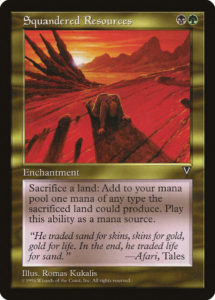 What now?
What now?
I was never a Standard player, but Arena hooked me by reducing the cost of a deck to $0 and rewarding me with free gold. It was smart of them and fun for me. The cost to play never increased for me, yet I haven’t played in almost a year. It isn’t fear of bannings that stops me, but the preponderance of overpowered cards that dominate formats, lead to repetitive games, and eventually get banned. Cauldron Familiar is a repetitive and uninteractive card, but so is Uro, Titan of Nature’s Warth. Wilderness Reclamation was miserable to play against, but Fires of Invention and Bolas’s Citadel suggest there are plenty more mana-undermining cards WotC is comfortable printing. I just didn’t enjoy enough games to keep playing, but banning cards isn’t enough to give me confidence that the next format is going to be any more fun or any less silly. But again, I’m not normally a Standard player, so perhaps my experience is far from typical.
Perhaps the biggest concern I have is the hidden cost of these bans. Sure, digital Magic lessens the sting of losing out on a Standard deck, but why should players be investing in physical Standard product now? It’s absolutely vital for their local game stores that people do so, but what confidence can Standard players even have that today’s chase cards won’t be tomorrow’s Obosh, the Preypiercer or Lukka, Coppercoat Outcast (rendered useless by nerfs or bans) or outright banned from play? What will tabletop Magic look like if the pandemic ends in the spring and players suddenly have to pick up a year’s worth of singles, rather than a set’s? I know that’s a problem for future Magic, but the seeds of that situation are already being sown.
—Zachary Barash is a New York City-based game designer and the commissioner of Team Draft League. He designs for Kingdom Death: Monster, has a Game Design MFA from the NYU Game Center, and does freelance gatame design. When the stars align, he streams Magic (but the stars align way less often than he’d like).

